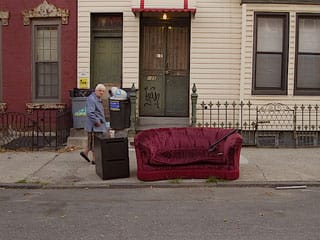All Style, No Substance: Williamsburg in 3D
Stereoscopic, or 3D, vision is a technique usually associated these days with blockbuster movies. But, using a simple stereo camera, Carlton Bright rollerbladed around Williamsburg from 2003 to 2013 documenting a series of “modules” or “vignettes” about the neighborhood he loves and calls home.

Stereoscopic, or 3D, vision is a technique usually associated these days with blockbuster movies. But, using a simple stereo camera, Carlton Bright rollerbladed around Williamsburg from 2003 to 2013 documenting a series of “modules” or “vignettes” about the neighborhood he loves and calls home. The word “love” is operative, as it’s the same chest-thumping, dyed-in-the-wool affection evinced by documentaries of cities like Guy Maddin’s “My Winnipeg” or Richard Sandler’s “Gods of Times Square.” Those films capture the grit, and especially in Sandler’s work, the gentrification, via spontaneous man-on-the-street interviews of the sad, funny, and outrageous characters abounding throughout his version of Gotham. The mad prophets were more than happy to mouth off on the changing scenarios around them, lending the film a poignant, narrative thrust.
In Bright’s film, WILLIAMSBURG: 3D of a Decade, which recently screened at Nitehawk Cinema, the wonder of 3D vision shows panoramic vistas of neighborhood rooftops swooping off into the East River, and they have a truly Lilliputian effect, turning cars and people into dollhouse pieces. It’s a setup that raises the question: what makes a civilization, a people, and a place in time? The vignettes that Bright includes, in both still photographs and 3D footage, are certainly authentic. There’s the Italian American Giglio feast, in which men affiliated with Our Lady of Mount Carmel Church lift the 55-foot-high Giglio Tower topped by a statue of San Paolino. The neighborhood’s whispered roots stretch back to the old Mafia, most notably Joey Bonanno, who grew up around Havemeyer Street.

There are a bevy of Bedford Avenue itinerant musicians: hungry, broke, traveling folk and outrageous subway performers. City dogs get their comeuppance, as do tightrope walkers in McCarren Park. Shots of the New York City Marathon, with its own group of loopy hipster cheerleaders, morph into a view of a street poet, who sits on the sidewalk behind a fold-out desk, pecking away on an old-fashioned typewriter, with a sign saying, “name a price, get a poem.” There is the lovely 3D origami of slow-motion flapping pigeon wings, the now copper (it used to be green, before the big money began pouring in) onion-bulb Russian Orthodox church dome anchoring McCarren Park, a wallop of a snowstorm, 3D snowflakes, the endless music festivals on the rebuilt waterfront, hipster Hassids wheeling around homemade menorahs, the wacky mini Bedford Avenue Halloween parade, and fireworks exploding on July 4th. Obama wins the Presidential election; hipster girl goes topless and hipster boy strips down to his undies for a celebration atop a car roof on Bedford Avenue.

After a while, though, the thrill of 3D winds down, and the fabulous Neverland of Williamsburg becomes a place where nobody seems to work and the parties are endless, like the Moulin Rouge during the time of Toulouse-Lautrec. September 11 is referenced for just a few seconds via the nighttime Tribute in Light, and rapacious development boils down to a few moment of pterodactyl-like cranes chewing up buildings like toothpicks. Most people are white, privileged, or at least downwardly mobile, and unbelievably daffy.

Bright glides over the substance of neighborhood issues with the speed of his rollerblades. He hasn’t shown the Polish/Ukrainian or Hispanic anger over displacement; El Puente is nonexistent. Disgraced former Assemblyman Vito Lopez’s solid base of senior centers and low-income housing is nowhere to be seen. None of the political battles over rezoning appear, and none of the menace of terrorism hangs over the morning commute of thousands on the L train. No sight of the thousands of forced evictions of artists that happened after 2006 as a result of the rezoning of 2005. Hurricane Sandy, a film op waiting to happen, is surprisingly absent. Williamsburg is portrayed as just one enormous glistening soap bubble wafting by over the past 10 years.
Bright needs to push himself further and dig deeper, editing his massive, gorgeous inventory of 3D stock to develop tension and thematics beyond the purely aesthetic. A film that employs documentary methods and a cool technology should also tell a documentary story, not just glide by on technique and stereotypical characterization.
Carlton Bright’s WILLIAMSBURG: 3D of a Decade screened at Nitehawk Cinema (136 Metropolitan Avenue, Williamsburg, Brooklyn) on November 14.




